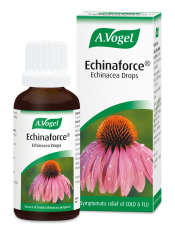A handful of Echinacea seeds
In the 1950s, Swiss herbalist Alfred Vogel met Oglala Lakota medicine man, Ben Black Elk, who introduced him to the medicinal properties of Echinacea, found growing in the wild in the North American prairies. Black Elk presented Vogel with a handful of Echinacea seeds which Vogel took back to Switzerland.
Vogel was so intrigued by the health benefits Echinacea possessed that he set about growing his own crop of Echinacea from the seeds gifted by Black Elk. At his clinic in Teufen, Vogel successfully germinated his small supply of seeds, carefully nurturing the seedlings. Before long, a good crop of Echinacea could be found growing in his herb garden.
Vogel harvested these Echinacea plants, using them to produce an Echinacea tincture which was used to treat his patients. This was the first of what was to become one of the most popular herbal remedies for colds & flu used in the UK and many parts of Europe – A.Vogel Echinaforce® Echinacea drops and tablets.
Growing Echinacea for Echinaforce®
Today, A.Vogel cultivates acres of Echinacea plants from seed, growing them organically in Switzerland. We are one of the very few herbal manufacturers still growing our own herbs. We avoid buying medicinal herbs from third party herb brokers if possible, preferring to have full control over the supply of our medicinal herbs – from seed to harvest.
However, not all the Echinacea plants we grow are used to produce medicines. Each year, a field of Echinacea is left to go to seed – these seeds are collected to produce seedlings for next season’s crop.
Tips from our expert gardeners
Here are some tips from our expert gardeners on growing Echinacea plants from seeds.
- Before sowing your Echinacea seeds, plan where you will plant your seedlings when they are ready. Echinacea prefers growing in dry sunny spots and is drought-tolerant.
- From March fill some small 3 inch pots with good organic potting compost. Make a small hole in the compost with a pencil and pop two Echinacea seeds in before closing the hole over. Use degradeable pots for planting out later, allowing the plants to grow without disturbing the roots.
- Give the compost a light spray of water to bed the seeds in. Place the pots on a windowsill or in a greenhouse.
- As your Echinacea seeds germinate and start growing, keep the soil moist until the young plants are about 3 inches tall.
- After the last frost has gone, transplant your young Echinacea seedlings into a sunny spot in the garden to grow.
- Finally, protect your plants from slugs and snails by making a ‘beer trap’. Use a shallow container (such as a plastic plant saucer), sink this into the soil to ground level near the Echinacea plants and fill with beer.
Your Echinacea plants can be left to grow and flower unhindered for the entire summer, although the fading heads should be removed as soon as they go over to keep the display coming. Unless of course, you wish to have a supply of Echinacea seeds.
Plants will self-sow prolifically if not deadheaded. The dried cones can be collected in winter and the Echinacea seeds harvested and saved. When left to grow, established clumps can and should be divided every 4 to 5 years.





 Looking for our products in a store near you?
Looking for our products in a store near you?

